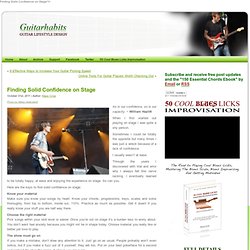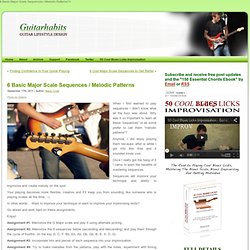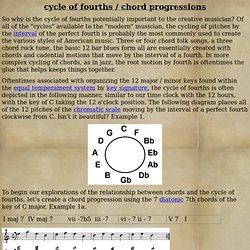

Ali1386 - L'Analisi Musicale della Musica Rock. 10 Essentials On Guitar Improvisation. Photo by Simone13 AKA John Pastorello Besides writing and playing songs I just love improvising. When I practice improvising I always first pour myself a cup of green tea, I put on some folk music (e.g. Ray La Montagne, Damien Rice, Stephen Fretwell, Glen Hansard, Sheryl Crow, etc.) on Last.fm or Spotify.com and then I start to improvise over these songs. I get totally caught up in the moment and let my fingers carry me away. Other times I practice melodic patterns, triads, arpeggios, licks, everything that will spice up my improvisation skills. Improvising is one of the most fun and fulfilling aspects of guitar playing, but also something that requires a lot of hard work and dedication. Here are 10 basic essentials that will help you become a better improviser. 1 – Pentatonics / blues Learn to play the pentatonic/blues scale all over the neck in all five shapes. 2 – Major Scale Next to the pentatonic scale, the major scale is the most important scale to learn.
Finding Solid Confidence on Stage. Photo by Niklas Hellerstedt As is our confidence, so is our capacity. ~ William Hazlitt.

21 Cool 3 Notes-Per-String Exercises to Rock On! Photo by Jsome1 Playing 3 notes per string exercises is something I do on a regular basis.

I use them to warm up, to become a faster guitar player and to spice up my improvisation. 3 notes per string licks and scales are generally used for speed picking. GuitarHabits.com. Photo by Jimi Glide Working on increasing your picking speed is not just for the hell fire speed guru wannabe’s.

Once your speed increases your whole style of playing loosens up. Your fingers will feel light and flexible and you’ll gain more freedom in your playing. Your fingers will float easily across the strings without trying so hard. It’s an important skill to work on and to maintain. Increasing your picking speed comes with obstacles, victories, ups and downs, lots of patience and hard work.
Every individual has it’s own specific hurdles to overcome, but if you focus on these tips you are already off to a great start. You can do it too! 1 – Practice slow Most people know this already but don’t have the patience to go slow. Do not ignore this rule or you will become a sloppy guitar player. Start out slow and gradually build up your speed. 2 – Use alternate picking The most used picking technique to increase speed is the alternate picking technique.
11) Notazione delle Note sul manico della chitarra ed Alcuni Accordi fondamentali - Voci Armoniche. 6 Basic Major Scale Sequences / Melodic Patterns. Photo by Gideon When I first learned to play sequences I didn’t know what all the fuzz was about.

Teoría - Music Theory Web. Tonal Theory Supplemental Examples. 5 Beautiful Ways to Play a II-V-I Jazz Chord Progression. Photo by Ava Weintraub I just love figuring out different ways to play a jazz chord progression or just mixing up jazz chords with other styles of music.

It can add nice flavors to a song and give it some extra magic. It’s really fun to experiment with that. Learning jazz expands your guitar vocabulary to a whole new level if you are ready for it. In the meantime it’s just fun to play some beautiful jazz chord progressions and it will certainly contribute to your playing skills and creativity as well. There are also more advanced II-V-I’s than the ones I show here but these are really nice to start out with and get your feet in the dirt. The Chord Guide: Pt I – Chord Progressions. Chord progressions are the canvas on which musicians paint their masterpieces, and it’s a canvas which is a piece of art in itself.

A chord progression can be subtle and in the background or it can be blatant and up front; it can be simple and catchy, or it can be technical and complex, it can stay in one key or it can change like the seasons. In any of these cases a chord progression is what drives the song as it literally shapes the music that accompanies it. Chord progressions are like a cozy home where melody and rhythm can kick their feet up. All the songwriting giants, like John Lennon, Paul McCartney, George Harrison, and Bob Dylan, to name a few, have/had a tremendous knowledge of the art of the chord progression.
Cool Jazz Chord Progressions for Guitar. Are you looking for some cool jazz chord progressions for the guitar?

Sometimes guitar players who are coming from a blues, folk or rock background think that jazz music is a cacophonous assortment of random notes. While such an argument could be made about some forms of free jazz, many jazz songs are based around standard progressions that aren't much different than the progressions found in other forms of music. Jacmuse music theory. Cycle of fourths / chord progressions. Cycle of fourths / chord progressions So why is the cycle of fourths potentially important to the creative musician?

Of all of the "cycles" available to the "modern" musician, the cycling of pitches by the interval of the perfect fourth is probably the most commonly used to create the various styles of American music. Three or four chord folk songs, a three chord rock tune, the basic 12 bar blues form all are essentially created with chords and cadential motions that move by the interval of a fourth.
In more complex cycling of chords, as in jazz, the root motion by fourth is oftentimes the glue that helps keeps things together. Oftentimes associated with organizing the 12 major / minor keys found within the equal temperament system by key signature, the cycle of fourths is often depicted in the following manner, similar to our time clock with the 12 hours, with the key of C taking the 12 o'clock position. Moving clockwise, can you see the similarities? Cool huh? Root motion by fourth.